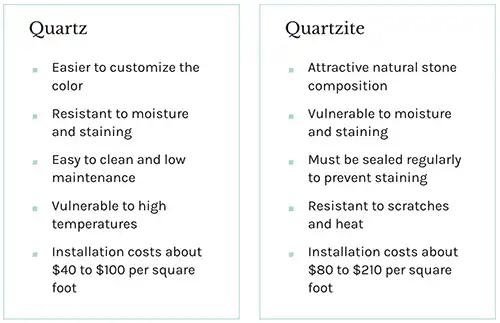Kitchen
Quartz vs. Quartzite: Understanding the Key Differences
Quartz vs Quartzite Differences: A Complete Countertop Guide
Quartz and quartzite are popular countertop materials homeowners love for their durability, style, and long-lasting beauty. However, confusion often arises when comparing quartz vs quartzite countertops because their names sound similar and their appearances sometimes overlap. Understanding these differences helps homeowners select the perfect surface that suits both lifestyle and design goals.
This detailed quartz vs quartzite comparison explores major distinctions in appearance, care, maintenance, durability, installation, cost, and lifespan. By evaluating these details, you can confidently choose the right countertop for your kitchen or bathroom renovation.
You might also enjoy the articles on our other site: Stripes Beauty Debuts ‘Hotter Than Ever’ Campaign
Quartz vs Quartzite: Major Distinctions

Although both materials deliver strength and elegance, quartz and quartzite have unique qualities. Quartz is engineered with 90–93% minerals and 7–10% resin binder, while quartzite is formed naturally from quartz-rich sandstone.
Quartz offers wide customization options, while quartzite provides unmatched natural beauty. Quartz resists water but struggles with heat, whereas quartzite resists scratches and heat but needs sealing to prevent water absorption.
Appearance: Style Matters in Countertop Selection
Quartz Offers Customizable Colors
Manufacturers create quartz countertops by adding pigments during production. This process produces endless color combinations, unique patterns, and precise hues for tailored kitchen or bathroom designs. Although quartz looks sleek, it lacks marble-like veining.
Quartzite Provides Natural Beauty
Quartzite retains natural veining, texture, and subtle color shifts from iron oxide, often producing elegant pinks and reds. Its authentic appearance appeals to homeowners seeking organic design rather than manufactured uniformity.
Water and Heat Resistance: Everyday Functionality
Countertops face frequent exposure to water and heat. Understanding how quartz and quartzite respond ensures long-lasting performance in kitchens and bathrooms.
Quartz Resists Moisture But Struggles With Heat
The resin binder inside quartz prevents water penetration, making it highly stain-resistant and easy to clean. Unfortunately, this same binder melts when exposed to temperatures above 300 degrees Fahrenheit. Hot pans or trays can cause permanent damage.
Quartzite Excels Against Heat But Requires Sealing
Quartzite withstands hot cookware easily, making it a strong option for active kitchens. However, quartzite’s porous surface requires frequent sealing to block moisture, oils, and other liquids from seeping into the stone.
Care and Cleaning: Ease of Maintenance
Quartz Requires Minimal Effort
Because quartz is non-porous, cleaning is simple. Use a soft sponge and mild cleaner to remove dirt or spills effectively. No sealing is required, making quartz countertops especially attractive for busy households seeking low-maintenance solutions.
Quartzite Requires More Attention
Quartzite demands sealing before cleaning with liquids. Without sealing, stains can penetrate the surface, leaving permanent marks. Although sealing protects quartzite, it requires consistent upkeep, making quartz easier to maintain overall.
Durability and Maintenance: Long-Term Strength
Quartz Delivers Reliable Durability
Quartz ranks about seven on the Mohs Hardness Scale, ensuring resistance against scratches, chips, and impact. Its resin binder adds extra protection, reducing ongoing maintenance responsibilities.
Quartzite Exceeds Quartz in Hardness
Quartzite ranks between seven and eight on the Mohs Hardness Scale. It resists scratches, chips, and dents better than quartz. However, homeowners must reseal quartzite every one to two years for full moisture resistance.
Installation: Professional Help Recommended
Quartz Installation Process
Quartz’s engineered structure allows flexible sizing, but each slab weighs 20–25 pounds per square foot. Professionals with lifting equipment usually complete installations safely and efficiently.
Quartzite Installation Challenges
Quartzite slabs weigh slightly less, around 20 pounds per square foot, but remain cumbersome. Their limited sizing flexibility makes installation even trickier. Professional installers are strongly recommended for quartzite countertops.
Cost: Budget Considerations
Quartz Offers Affordability
Quartz countertops cost about $40 to $100 per square foot. Pricing depends on customization, design complexity, and brand reputation. Quartz remains more budget-friendly overall.
Quartzite Reflects Natural Luxury
Quartzite ranges from $80 to $210 per square foot. This higher price reflects its natural origin, distinctive veining, and luxurious durability. Budget-conscious homeowners often choose quartz, while others invest in quartzite’s timeless appeal.
Lifespan: Long-Term Value
Quartz Countertops Last for Decades
With proper care, quartz countertops last 20–60 years. Their moisture-resistant structure makes them suitable for kitchens, bathrooms, and busy family households.
Quartzite Offers Timeless Longevity
Quartzite, when properly sealed, lasts 50–100 years. Its durability matches granite and marble, making it a wise investment for long-term kitchen or bathroom remodels.
Quartz vs Quartzite Differences: Making the Right Choice
When considering Quartz vs Quartzite Differences, weigh ease of cleaning, resistance to heat, maintenance effort, and overall cost. Quartz delivers customization, affordability, and easy maintenance. Quartzite provides unmatched natural beauty, superior heat resistance, and impressive durability.
For families seeking low-maintenance, quartz is often better. For homeowners prioritizing natural luxury and resilience, quartzite stands out despite requiring sealing.
Ultimately, the best choice depends on your budget, lifestyle, and design preferences. Understanding these Quartz vs Quartzite Differences ensures confidence in your countertop investment.
Frequently Asked Questions
Which countertop material is better overall?
Quartz is easier to install, clean, and maintain, making it the better choice for most homeowners. Quartzite, however, excels in heat resistance.
What are the disadvantages of quartzite?
Quartzite is more expensive than quartz and requires sealing every one to two years. Without sealing, it becomes vulnerable to staining.
Can you place hot pans on quartz?
Avoid placing hot pans directly on quartz surfaces. The resin binder may melt when exposed to extreme heat above 300 degrees Fahrenheit.
Final Thoughts on Countertop Selection
Choosing between quartz and quartzite requires evaluating lifestyle needs, maintenance preferences, and budget. Quartz favors practicality, while quartzite rewards patience with unmatched elegance and endurance.
When carefully maintained, both options elevate kitchens and bathrooms while increasing overall property value. However, taking time to compare them ensures you select a surface that matches your personal goals.
You might also enjoy the articles on our other site: 5 Must-Have Vitamin D Drops for Infants
Explore more home design inspiration and detailed countertop guides on this website for smart renovation decisions and stylish living spaces.